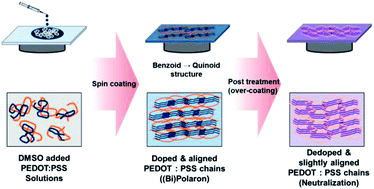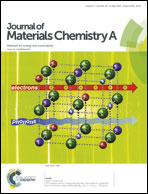Enhanced thermoelectric properties of PEDOT:PSS nanofilms by a chemical dedoping process†
Abstract
We report that a simple chemical dedoping treatment of poly(3,4-ethylenedioxythiophene):poly(styrenesulfonate) (PEDOT:PSS) nanofilms enhances the thermoelectric properties of the polymer nanofilms. The dedoping process was done by over-coating a mixture of dimethyl sulfoxide (DMSO) and hydrazine (HZ), a strong chemical reducing agent, onto the PEDOT:PSS nanofilms. This additional step led to the removal of excess PSS chains and the formation of neutral states of PEDOT chains, resulting in an improvement in the Seebeck coefficient, from 30 μV K−1 to 142 μV K−1, and a decrease in the electrical conductivity from 726 S cm−1 to 2 S cm−1. By controlling the concentration of HZ, we obtained an optimized power factor of 112 μW m−1 K−2 at 0.0175 wt% of HZ in DMSO at room temperature. The corresponding electrical conductivity and Seebeck coefficient under optimized conditions were 578 S cm−1 and 67 μV K−1, respectively. We expect that this simple dedoping process can be applied to general thermoelectric nanofilms based on chemically doped polymers in order to enhance the power factor.


 Please wait while we load your content...
Please wait while we load your content...